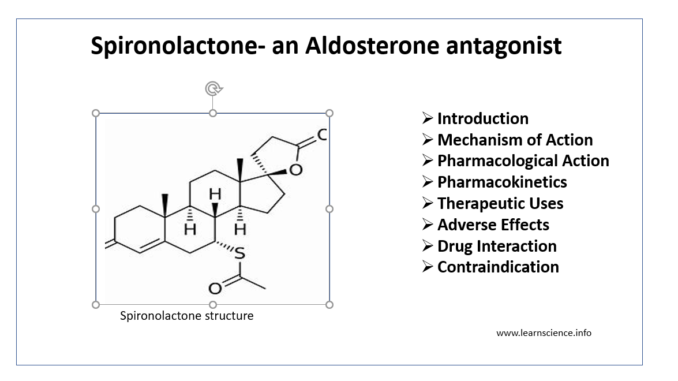
- Spironolactone is potassium-sparing diuretic which is structurally similar to aldosterone.
- It was discovered in 1957 and introduced in 1959. Spironlactone is on the WHO’s (World Health Organization) list of essential medicines and is available in both generic and brand from.
- It is synthetic steroid and is commonly used aldosterone antagonist.
Mechanism of action of Spironolactone
- Aldosterone is steroid hormone mainly synthesized in adrenal cortex but is also found in brain, heart and adipose tissues. It is an important regulator of sodium, potassium and water homeostasis.
- Aldosterone binds to specific mineralocorticoid receptor (MR). This MR-aldosterone complex translocates to nucleus and regulate expression of aldosterone induced proteins (AIPs) which stimulate Na+/K+ exchange sites.
- Spironolactone acts by competitive antagonism of aldosterone. It inhibits binding of aldosterone to specific MR in distal part of nephron.
- The MR-spironolactone complex is unable to induce synthesis of AIPs. The lack of these proteins prevent Na+ reabsorption and K+ and H+
Pharmacological actions of Spironolactone
Effect on urinary excretion
- In most cases of edema, aldosterone level is high in blood which cause sodium retention.
- Spironolactone antagonizes aldosterone and increases Na+ excretion and causes retention of K+. It has little or no effect on renal hemodynamics.
- The higher the level of endogenous aldosterone, the higher will be the effect of spironolactone on urinary excretion.
Other actions
- It has some affinity towards progesterone and androgen receptor which is responsible for various side effects. Another aldosterone antagonist, eplerenone has very less affinity toward progesterone and androgen receptor.
Pharmacokinetics
- It is administered through oral route. It has a short half-life of 1.6 hours. Portein binding property is extensive (around 90%). Bioavailability of an oral dose is approximately 60-90 %.
- Metabolism takes place mostly in liver. The active metabolite canrenone with half-life of 17 hours is responsible for majority of its actions. Several other inactive compounds are also formed as result of metabolism.
- Primary excretion is via urine. Some % is excreted through feces.
Therapeutic Uses of spironolactone
In primary and secondary hyperaldosteronism
- In primary hyperaldosteronism, it corrects electrolyte abnormalities and lower blood pressure.
- It is effective in hepatic cirrhosis and nephrotic syndrome associated with secondary hyperaldosteronism.
Diuretic
- Although it is less effective when compared to other diuretics, it possesses useful property of retaining potassium ions. So, it is used in combination with thiazide or loop diuretics to prevent K+ excretion which usually happens with these drugs.
- It is preferred diuretic in patients with hepatic cirrhosis.
Heart Failure
- Spironolactone helps to reduce both morbidity and mortality by treating edema, fluid retention and symptoms of heart failure. It is added in low dose to standard treatment.
- It is mostly effective in heart failure associated with reduced ejection fraction (mostly left ventricular ejection fraction of less than 35%).
Resistant hypertension
- It is used as fourth line add on therapy in patients with uncontrolled, resistant hypertension who don’t respond to other anti-hypertensive agents. It is effective in either condition with or without elevated aldosterone level.
Ascites
- Accumulation of fluid in stomach (ascites) is common complication of hepatic cirrhosis. Spironolactone is effective in such condition.
Polycystic Ovarian Syndrome (PCOS)
- At high doses, it blocks androgen receptor and inhibit steroid synthesis. It is used off-label for treating increased androgen level seen in PCOS.
Transgender hormone therapy
- It is used off-label as a component of feminizing hormone therapy in transgender woman. Its clinical effects include induction of breast development, decreased male pattern body hair and lack of spontaneous erections.
Adverse Effects
- It can produce serious hyperkalemia and metabolic acidosis in patients with renal insufficiency.
- Common side effects include GI disturbance like gastric upset, diarrhea, peptic ulcer, gastric bleeding. CNS disturbances include lethargy, headache, dizziness, ataxia and mental confusion.
- It can induce gynecomastia in male patients and menstrual irregularities in female. It can cause impotence and decreased libido synthesis.
Drug Interaction
- Concurrent administration with other potassium sparing diuretics, potassium supplements, ACE inhibitors and ARBs (Angiotensin Receptor Blocker) may cause serious hyperkalemia. So, it should not be used with these drugs.
- It can increase plasma concentration of digoxin.
- Salicylates may reduce tubular secretion and diuretic efficacy of spironolactone.
Contraindication
- Contraindicated in patients with hyperkalemia and who are at increased risk of developing hyperkalemia due to any disease or use of any medications.
- Used with caution in elder patients, patients with renal insufficiency and hepatic impairment.
- Avoided in patients with acid-peptic disease.
References
- Kalidindi SR, Tang WW, Francis GS. Drug Insight: aldosterone-receptor antagonists in heart failure-the journey continues. Nature Clinical Practice Cardiovascular Medicine. 2007; 4: 368-378.
- Dudenbostel T, Calhoun DA. Use of Aldosterone Antagonists for Treatment of Uncontrolled Resistant Hypertension. American Journal of Hypertension. 2017; 30(2): 103–109.
- Guichard JL, Clark D, Calhoun DA, Ahmed MI. Aldosterone receptor antagonists: current perspectives and therapies. Vasc Health Risk Manag. 2013; 9: 321–331.
- Carone L, Oxberru SG, Twycross R, Charlesworth S, Mihalyo M, Wilcock A. Spironolactone. Journal of Pain and Symptom Management. 2017; 53(2): 288-292.
- Goodman and Gillman’s Manual of Pharmacology.
- Pharmacology and pharmacotherapeutics. 24th edition
- Lippincott Illustrated Reviews Pharmacology. 6th edition.